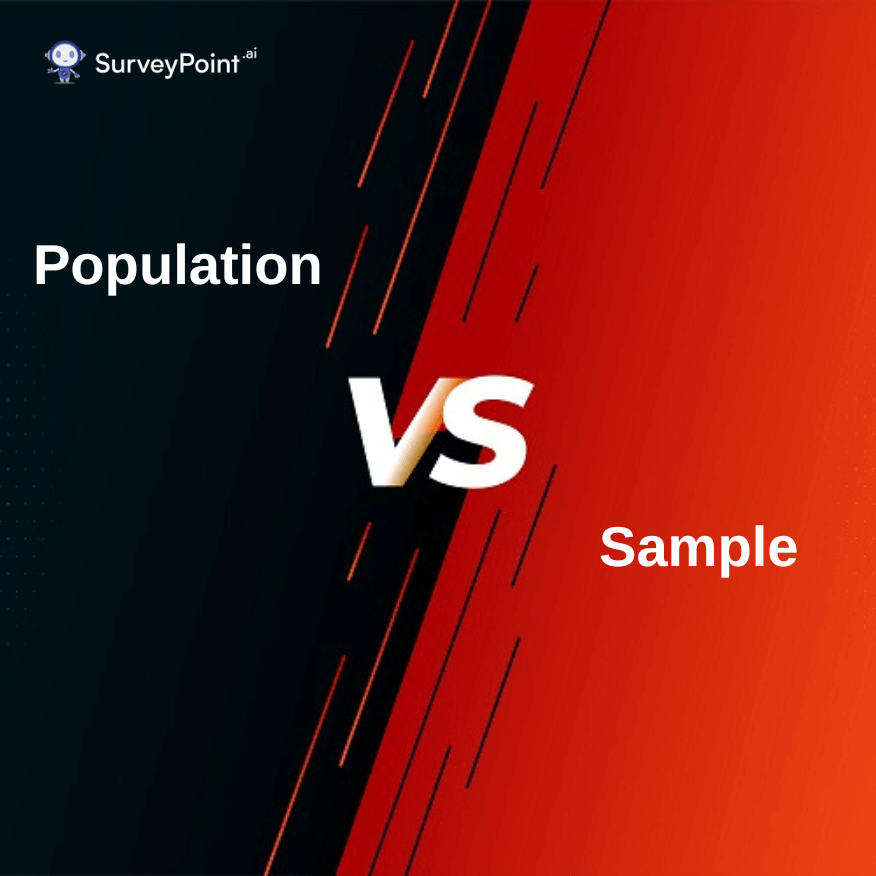
Whether it’s people, animals, or plants, everything is unique in its own way. Studying such a diverse group of entities can be a daunting task. So, researchers often use sampling to study a smaller, more manageable subset of the population. This article will explore the subtle differences between population vs sample and how they impact market research.
Before diving into the differences between population and sample, let’s define these terms.
Market research gathers and evaluates data about a specific market, product, or service.
It aims to understand human needs and preferences to enhance business strategies. One of the key concepts in market research is understanding the difference between population vs sample.
Population in Market Research

Source: VOXCO
Defining Population
The population in market research refers to the whole group of individuals, objects, or events the researcher is interested in studying. It is the entire universe of the research question.
For example, we want to know the preferences of all car buyers in the United States. Then all US car buyers would make up the population.
Types of Population
There are two types of populations in market research: finite and infinite. An infinite population refers to an uncountable group like stars or grass.
Conversely, a population of finite size refers to a particular group of people, things, or events that can be counted.
For instance, all students in a school can be considered a finite population, while all internet users worldwide can be viewed as an infinite population.
Sample in Market Research
Defining Sample
A sample in market research refers to a subset of the population selected for research purposes. A smaller group of individuals, objects, or events represents the larger population. A business may want to know the choices of American car purchasers. They can opt for a subset of 1,000 car buyers from various regions and demographic groups as their sample.
Importance of Sampling
Sampling is essential to market research because it is not always feasible or cost-effective to study the entire population. It allows researchers to draw inferences about the larger population based on the data collected from a smaller group.
Additionally, it guarantees that the information gathered accurately represents the population, enhancing the research outcomes’ accuracy and dependability.
Types of Sampling
There are four main types of sampling techniques:
- simple random sampling,
- systematic sampling,
- stratified sampling, and
- cluster sampling.
1. Simple Random Sampling
One of the most basic forms of sampling is simple random sampling, where each person in the population has a chance of being chosen equally. This method usually employs a random number generator or a table of random numbers.
2. Systematic Sampling
This sampling entails choosing people from the population at predetermined intervals, such as every tenth name on a list. The list is in random order, which is helpful when there is a large population to choose a random sample from.
3. Stratified Sampling
A random sample is chosen from each subgroup after the population is divided into subgroups or strata according to a specific characteristic, such as age or gender, in stratified sampling.
4. Cluster Sampling
A few clusters are randomly chosen to be studied after dividing the broader population into clusters, such as neighborhoods or schools.
Differences Between Population vs Sample
To begin with, when conducting research, it’s essential to understand the distinction between the population and the sample.
- The population is the entire group of individuals that the researcher is interested in studying, while the sample represents only a subset of that group.
- Therefore, the information collected from the sample draws conclusions about the entire population. Choosing the sample is vital to ensuring it correctly represents the population. Since the population vs sample is often significantly larger than the sample, it is critical to select a representative sample.
- Additionally, studying the entire population may be impractical due to its size. As a result, researchers frequently conduct in-depth studies of samples to get a deeper understanding, which is then applied to generalize to the community at large.
Why Should I Choose a Sample from a Population?
When conducting research, choosing a sample from a population vs sample is often necessary. Here are seven reasons why selecting a sample is crucial:
- Cost: Collecting data from the entire population can be prohibitively expensive. A representative sample can provide comparable results at a fraction of the cost.
- Time: Gathering data from the whole population may require significant time, whereas a sample can provide information more quickly.
- Accessibility: It may not be possible to obtain information from the entire population, particularly if it is dispersed geographically or hard to reach. A sample can be selected more easily.
- Manageability: Collecting data from a large population can be challenging to manage. Choosing a smaller sample size can make the research process more manageable.
- Accuracy: Data obtained from a well-selected sample can often be just as accurate as that obtained from the entire population.
- Practicality: In some cases, collecting data from the entire population may not be feasible or necessary. In these instances, selecting a sample is the most practical option.
- Validity: If a sample is chosen correctly, it can be representative of the entire population, leading to valid conclusions from the research.
Conclusion
Population vs sample are two critical concepts in market research. The population represents the entire interest group, while the sample is a subset.
Market researchers cannot extrapolate to the entire population from data obtained on a smaller subset. Thus, sampling is crucial to their work.
By understanding the differences between population vs sample, researchers can conduct more accurate and meaningful market research.
FAQs
Q: Why is sampling important in market research?
A: Sampling is vital because studying the entire population is not always feasible or cost-effective. It allows researchers to draw inferences about the larger population based on the data collected from a smaller group.
Q: What are the different types of sampling techniques?
A: The main types of sampling techniques are simple random sampling, systematic sampling, stratified sampling, and cluster sampling.
Not Sure Where To Begin?
Explore our solutions to discover what is most important to your customers,
clients, and prospects. And best of all – it doesn’t take any coding!
Free Trial • No Payment Details Required • Cancel Anytime




